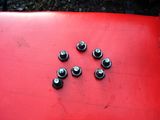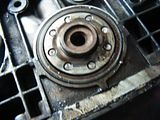Post #17
Lol. M50 is just a metric stud, like M6 or M8 only 2" basically lol.

Simply put, because you have to stretch the bolt to 0.15 or so, you can't rely on torque settings alone to maintain the flange clamp loads when the cylinder equalizes at operating temps (hundreds in the HP cylinder, it's a big lump of steel sitting at room temp when you assemble it). You fit a stud hand tight, minus 1/8 of a turn to attempt to prevent seizing. You drop the casing top half on (10 tons or so lol) and then you wind the M50 cap nut down the thread til it goes hand tight. The cap nut has a hole in the top, and the stud a hole along it's length. Drop in a bolt heater (think immersion heater but for free air), commence heatage for half an hour or so, come back and carefully wind down the cap nut (it's hot!) til it bottoms and allow to cool. Drop in a calibrated meausuring rod and record the new stud length, compare to the stud's free length before it all kicked off and work out the stretch. Work out how many turns equated to what stretch and re-heat to slacken/tighten as required to achieve desired stretch. Job done, when it all heats up it'll have the correct clamp load!

This is a Hytorq, used for silly torque loads. The 4 teeth per inch thread i mentioned above is an ACME thread, it was 12". To resist that much torque needed a brace, it was assembled into a frame which utilised 4 of the valve chest M50 studs. Imagine 4 studs bending as the torque reaches the correct value. I have a picture somewhere on my work laptop of it.

Mental things they are, basically a glorified hydraulic ratchet.
</boring mode>
________________________________________
I'm Si btw
 Night Blue
Night Blue VW Golf GTD
Bianca LBSC Rallye - Track/Road Slag
Project Thread
Sparkling Silver Mini Cooper D -
Super Dooper 
- (The other half's wheels)



 - (The other half's wheels)
- (The other half's wheels)




 tvrfan007
tvrfan007







 Best torque i've come across yet is 30000 lb/ft on a 4tpi valve seat using a Hytorq - made the bracing studs flex (4 M50's holding the driver).
Best torque i've come across yet is 30000 lb/ft on a 4tpi valve seat using a Hytorq - made the bracing studs flex (4 M50's holding the driver). 

